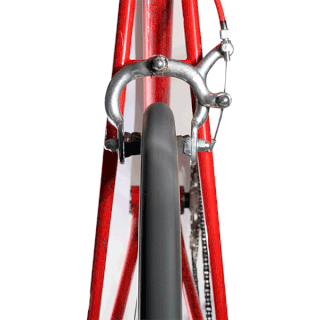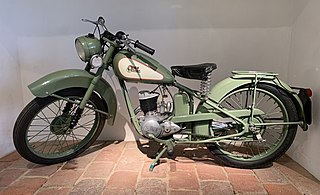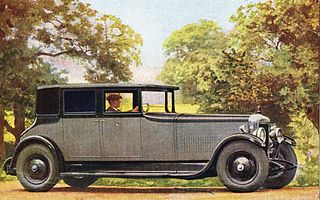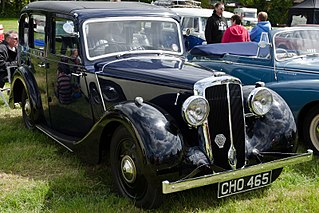
A bicycle brake reduces the speed of a bicycle or prevents the wheels from moving. The two main types are: rim brakes and disc brakes. Drum brakes are less common on bicycles.

In mechanical or automotive engineering, a freewheel or overrunning clutch is a device in a transmission that disengages the driveshaft from the driven shaft when the driven shaft rotates faster than the driveshaft. An overdrive is sometimes mistakenly called a freewheel, but is otherwise unrelated.

Trojan was a British automobile manufacturer producing light cars between 1914 and 1965, and light commercial vehicles for a short time.

The BSA Bantam is a two-stroke unit construction motorcycle that was produced by the Birmingham Small Arms Company (BSA) from 1948 until 1971. Exact production figures are unknown, but it was between 350,000 and 500,000.

The Swift Motor Company made Swift Cars in Coventry, England from 1900 until 1931. It grew progressively from James Starley's Coventry Sewing Machine Company, via bicycle and motorised cycle manufacture. The cars ranged from a single-cylinder car in 1900 using an MMC engine, through a Swift-engined twin-cylinder 7-horsepower light car in 1904, and a 3-litre model in 1913. After the First World War a successful range was sold during the 1920s, but the Cadet of 1930 was its last vehicle as it could not compete economically with volume manufacturers such as Ford and Morris Motors.
The Sheppee was an English steam automobile manufactured in York by the Sheppee Motor Company run by Colonel Francis Henry Sheppee, son of Lieutenant-Colonel Francis Faulkener Sheppee (1835–1913). After long service with the army in India, Colonel F.H. Sheppee created the Sheppee Motor Company in Thomas Street, York around 1902. The firm mainly made steam-driven commercial vehicles but in 1912 at least two passenger cars were made with 25 hp engines and flash boilers. In 1913, they announced they had got a site on the Birmingham Road near Worcester where they would build a new factory for production of their 3-ton steam wagons.

The R60 and R60/2 are 600 cc boxer-twin that were manufactured from 1956 to 1969 in Munich, Germany, by BMW.

The Rover 6 was a small two-seater 6-horsepower car and only the second car model made by the British Rover car company. Announced in January 1905 a 6-horsepower car remained available from Rover until 1912.

The Austin 10 hp is a high-quality small car produced between 1910 and 1915 by the British car manufacturer Austin Motor Company Limited at their Longbridge, Worcestershire plant near Birmingham. 1,336 cars were made, 213 with the 1125 cc engine and 1,123 with the 1615 cc engine. Like the 1087 cc Austin 7 hp produced by both Austin and Du Cros's Swift Motor Company it was not very successful when sold with the small engine.
The "Pure Enduro" series of off-road racing motorcycles ran from 1977 through to 1984 in engine displacements from 175cc through 400cc. All engines were case-reed valve, air-cooled, two-stroke and single-cylinder with plain steel bores. Lubrication was provided via 20:1 pre-mix. These were directly related to the Suzuki RM series range of motocross racers.

The Daimler Double-Six sleeve-valve V12 was a piston engine manufactured by The Daimler Company Limited of Coventry, England between 1926 and 1938. It was offered in four different sizes for their flagship cars.

The Lanchester Eighteen at first known as the 15/18 was announced at the beginning of October 1931. Quite unlike any previous Lanchester it was their first new car following BSA's takeover of The Lanchester Motor Company Limited in January 1931. A medium sized car was a new departure for Lanchester.

The Lanchester Fourteen Roadrider is a six-cylinder automobile introduced by the Lanchester Motor Company in the beginning of September 1936. It was named "Roadrider" for its special suspension features, and billed as the lowest-priced six-cylinder Lanchester ever offered. This car replaced the previous 12 hp Light Six model with a larger six-cylinder engine again in the Lanchester Eleven chassis and body.
The Austin 15-20 is the smaller-engined of the almost identical pair of new cars announced by Herbert Austin in February 1906. A very complete catalogue with detailed specifications was issued at the same time. As well as the engine's smaller bore the 15-20 differed from the 25-30 by being only available with a live rear axle and not chain-drive. Otherwise the specifications were the same, the very minor differences are detailed below.

The Ducati 350 Mark 3 is a 340 cc (21 cu in) single cylinder bevel drive SOHC motorcycle produced by the Italian manufacturer Ducati from 1968 to 1974. It was one of the first 'wide case' Ducati singles produced. A higher performance version, the Ducati 350 Mark 3D, which used desmodromic valves was also available.
The Ducati Diana Mark 3, also known as the Ducati Diana SuperSport and commonly referred to as the Ducati Mark 3, is a 249 cc (15.2 cu in) single cylinder bevel drive SOHC motorcycle produced by the Italian manufacturer Ducati from 1962 to 1966. It was a higher performance version of the Ducati Diana and sold to the American market only. In 1963, Cycle World described it as "the fastest, and nearly the smoothest, standard motorcycle in the 250cc class". It was replaced in 1967 by the Ducati 250 Mark 3.

The Ducati 450 R/T (road/trail) is a 436 cc (26.6 cu in) single cylinder bevel drive desmodromic SOHC motorcycle produced by the Italian manufacturer Ducati from 1971 to 1974. Initially produced at the request of the American importers Berliner Motor Corporation as a motocross / enduro motorcycle offered exclusively to the American market, and only a few hundred machines were made of this type. It is the only off-road racing motorcycle to use desmodromic valves. An optional street equipment kit was available. From 1972 it was produced for the European Market as a street legal on/off-road machine, which was sometimes known as the 450 T/S.
The Ducati 100 Scrambler is an on/off-road 98 cc (6.0 cu in) single cylinder two stroke motorcycle produced by the Italian manufacturer Ducati in 1970 and 1971. The model was produced to take advantage of the dirt bike craze in Italy at the time. The model used many parts from existing models, keeping R&D costs down. A smaller engined version, the 50 Scrambler, was also produced. The model did not sell well and was soon dropped.
The Ducati 100 Scrambler is an on/off-road 50 cc (3.1 cu in) single cylinder two stroke motorcycle produced by the Italian manufacturer Ducati in 1970 and 1971. The model was produced to take advantage of the dirt bike craze in Italy at the time. The model used many parts from existing models, keeping R&D costs down. A larger engined version, the 100 Scrambler, was also produced. Styling was similar the 125 Cadet Scrambler. The model did not sell well and was soon dropped.













